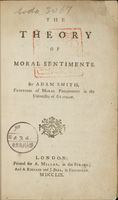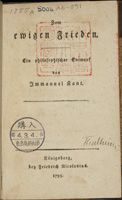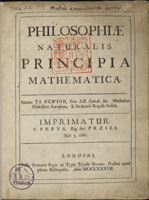The Soda Bunko
This collection of works on the history of philosophy, assembled by Professor Kiichiro Soda (1881-1927), economic philosopher and bank president, was acquired in 1929. It contains approximately 8,100 books and bound periodicals, and is particularly strong in materials relating to Immanuel Kant.
Literature
- Katalog der Soda Kiichiro-Bibliothek in der Handels-Universitat Tokio, Tokio : Bibliothek der Handels-Universitat Tokio, 1942. (15.7MB)
- 太田可夫「左右田文庫に就て」、『一橋大学附属図書館史』一橋大学、1985年
- 渡植彦太郎「左右田文庫に因みて 」、『一橋大学社会科学古典資料センター年報』第3号、1983年
- 太田可夫「左右田文庫の分類を終へて」、『一橋論叢』第8巻第2号、1941年
- 太田可夫「左右田文庫の内容」、『一橋論叢』第5巻第6号、1940年
- 福島 知己「左右田文庫について少々」、『一橋大学社会科学古典資料センター年報』第34号、2014年
Adam Smith’s Theory of Moral Sentiments
The theory of moral sentiments
(Soda Ab.952)
Publication details
The theory of moral sentiments / by Adam Smith
Publisher: London : Printed for A. Millar, in the Strand; and A. Kincaid and J. Bell, in Edinburgh
Publication Date: 1759
Physical Description: [12], 551, [1] p. : 21 cm
Notes: Errata: p. [1] at end
Author: *Smith, Adam, 1723-1790
Language: English
Explanation
Published in 1759, this is the work with which Adam Smith, 1723-90, made his literary debut. Ethical subjects within lectures on moral philosophy are developed here. Beginning with a definition of the idea of sympathy, it finds the principles of propriety of action and sentiment in the sympathy that a disinterested spectator would feel when standing in another person’s situation. Smith’s ethical aim was the socialization of instinctive impulses by making the principle of human communication that of the impartial eyes of strangers regarding one another. This work is thus less an ethical work in the strict sense than a methodical discourse to construct an empirical theory of natural law, to take the place of F. Hutcheson’s moral philosophy and its central system of natural philosophy based on the moral sense and principles of mutual benevolence. He argues, in the first half of this work, mainly about the foundation of the virtue of justice in relationships between human beings, drawing a sharp distinction between ethics and law; in the second half, he takes up practices contrary to the principles of nature for criticism, and criticizes utilitarianism. He does not approve of laissez-faire principles without reserve, but takes a stand for fair and free competition.
Kant’s Metaphysics of Morals
Die Metaphysik der Sitten
(Soda/Ab.564)
Publication details
Die Metaphysik der Sitten in zwey Theilen / abgefasst von Immanuel Kant
Publisher: Königsberg : Bey Friedrich Nicolovius
Publication Date: 1797
Physical Description: 1 v. (various pagings) ; 21 cm
Notes: Description based on: Metaphysische Anfangsgrunde der Tugendlehre
Contents: Metaphysische Anfangsgründe der Tugendlehre / von Immanuel Kant. 1797 — Metaphysische Anfangsgründe der Rechtslehre / von Immanuel Kant. 1797
Author: *Kant, Immanuel, 1724-1804
Language: German
Explanation
Immanuel Kant, 1724-1804, ranks among the greatest philosophers of European modern times. This system of practical philosophy is one of his latest works. It is divided into two main parts: the first deals with metaphysical principles of the doctrine of right and the second with metaphysical principles of the doctrine of virtue. The first part involves the philosophy of law and is divided into private law and public law. He attempts to give philosophical grounding to possession, the State, external coercion, perpetual peace, the international league and so on, and provides the Kantian philosophy of law and political philosophy in its most definitive form. The second part is often called “Ethics," and it does indeed constitute a substantial system of ethics. It develops systematically the concrete duties of virtue as self-preservation, self-education and the promotion of the happiness of others. In this way the Metaphysics of Morals constitutes a philosophy of law and substantial ethics as a system of practical philosophy.
Kant’s Perpetual Peace: A Philosophical Sketch
Zum ewigen Frieden : ein philosophischer Entwurf
(Soda/Ab.591)
Publication details
Zum ewigen Frieden : ein philosophischer Entwurf / von Immanuel Kant
Publisher: Königsberg : Bey Friedrich Nicolovius
Publication Date: 1795
Physical Description: [2], 104 p. ; 18 cm
Author: *Kant, Immanuel, 1724-1804
Language: German
Explanation
This is one of the best-known works of Immanuel Kant, in which he advocates the necessity of nations to form a league by agreement (rather like the United Nations formed after World War II) in order to establish perpetual international peace, as it is impossible to oblige nations to renounce their sovereignty. Kantian moral philosophy consists in “personalism" (which is the supreme moral goal of a person to pursue as his purpose). However, even though the moral goal is to attain a liberal personality, society would fall into chaos and the moral goal could not be attained if each did as he pleased. As no power exists beyond the state, we cannot avoid international conflicts and wars and the attainment of personality as an essential human purpose becomes extremely difficult. To secure the kind of life appropriate for a human being international peace is a prerequisite, and to achieve that a league of nations is necessary. This work is frequently quoted in all substantial examinations of thinking about peace.
Newton’s Principia
Philosophiae naturalis principia mathematica
(Soda/Ab.779)
Publication details
Philosophiae naturalis principia mathematica / Is. Newton
Publisher: Londini : Jussu Societatis Regiae ac Typis Josephi Streater …
Publication Date: 1687
Physical Description: 383, 400-510 p. ; 25 cm
Notes: “Imprimatur, S. Pepys, Reg. Soc. Praeses. Julii 5. 1686."
Author: *Newton, Isaac, Sir, 1642-1727
Language: Latin
Explanation
Philosophiae naturalis principia mathematica is Newton’s chief work beside his Opticks. In 1684 the Royal Society held a meeting where the problem was presented of how the inverse-square law led to planetary motion, and it was this that provided the opportunity for Newton to begin the work. Its first edition was published by Edmund Halley at his own cost. It is thought that about 400 copies of the first edition were printed. Two variants are known according to the publication details on the title page: one for domestic sales, another for export with the name of the seller Samuel Smith. The CHSSL copy is of the domestic edition. The domestic edition itself has several variants, and the CHSSL copy lacks the foldout plate describing the orbit of comets as well as corrigenda.








